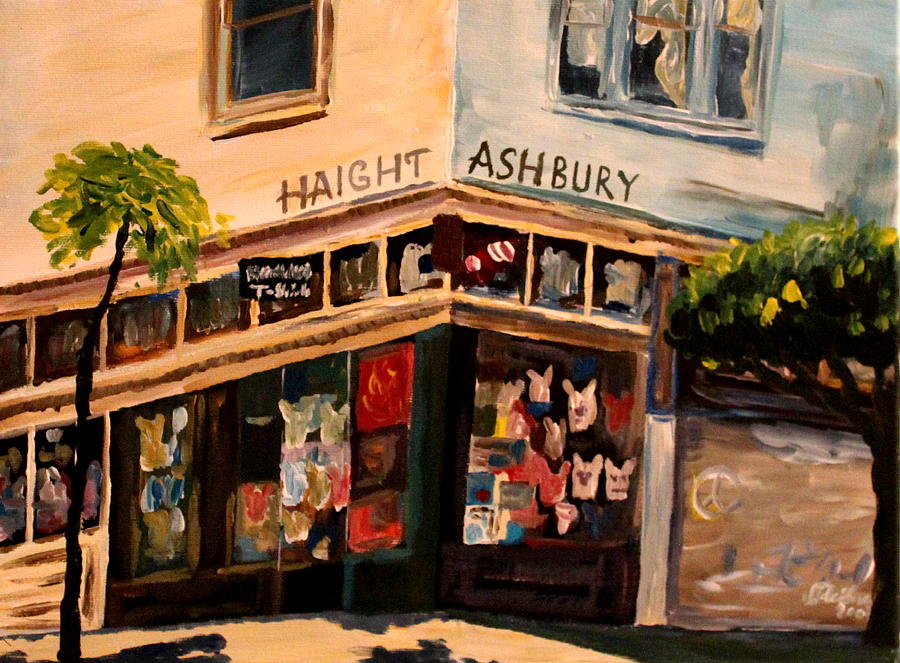You Finally Made It
After the dope
wore off
and the voices kicked in
without even
a shirt on your back
in socks spotted
with blood
clutching a Glad bag
containing pizza crusts
and other garbage
Welcome! Welcome!
you finally made it
to San Francisco.

Love N Haight In Haight Ashbury -- M Bleichner
The Haight-Ashbury district of San Francisco, California, was the center of the American hippie movement of the 1960s.
ReplyDeleteHenry Haight, an American exchange banker during the California Gold Rush era, and Munroe Ashbury, a member of the San Francisco Board of Supervisors from 1864-70, were involved in planning the neighborhood and the nearby Golden Gate Park. In the 1950s beats like Allen Ginsburg had congregated around the North Beach neighborhood before migrating to the relatively cheap, underpopulated Haight-Ashbury, which had previously been the city's principal African-American and Japanese neighborhoods. The 1st "head shop," Ron and Jay Thelin's Psychedelic Shop, opened on Haight Street in 1966. Later that year Emmett Grogan, Peter Coyote, Peter Berg, and Billy Landout of the San Francisco Mime Troupe guerrilla theater group organized the Diggers, a street theater group that began publish various broadsides featuring poetry, psychedelic art, and essays, and featured slogans such as "Do your own thing" and "Today is the first day of the rest of your life." They provided free stews made with donated or stolen meat and vegetables, served behind a giant yellow picture frame called the Free Frame of Reference;
opened numerous Free Stores in Haight-Ashbury, in which all items were free for the taking or giving; opened a Free Medical Clinic staffed by volunteers from the University of California, San Francisco medical school; arranged free "crashpads" for homeless youth drawn to the Haight-Ashbury area; and threw free parties with music provided by local bands such as the Grateful Dead, Jefferson Airplane, Big Brother & the Holding Company with Janis Joplin.
During the 1967 Summer of Love, psychedelic rock music began airing on commercial radio airplay, especially after the success of Scott McKenzie's "San Francisco (Be Sure to Wear Flowers in Your Hair)," written by John Phillips of The Mamas & the Papas, and the attention local bands received at the Monterey Pop Festival in June. "Time" magazine featured "The Hippies: Philosophy of a Subculture" on its cover, and "CBS News" reported on "The Hippie Temptation." Hunter S. Thompson wrote about "Hashbury" in "The New York Times Magazine." But the neighborhood could not accommodate the rapid influx of people, and it became prey to overcrowding, homelessness, hunger, drug problems, and crime. In October 1967 the Diggers staged their final happening, "The Death of Hippie, on which masked participants carried a coffin with the words "Hippie--Son of Media" on the side, signalling the end of the Haight's utopian ideals. However, The Farm, the Rainbow family, and hundreds of other hippie communes persisted; Kerista, the last one, had begun in New York in 1956 by John Presmont after an auditory hallucination told him he was the founder of the next great world religion. After stints in Dominica, Honduras, and Belize, he took his community to California in the late 1960s. Robert A. Heinlein's 1961 science fiction novel "Stranger in a Strange Land" was compulsory reading. The group's mottoes included "Wash your own dish," "No one belongs to anyone else," and "Kerista is freedom and love." It developed the concepts of polyfidelity (being sexually active with all other members, but only with group members) and compersion (the empathetic state of happiness and joy experienced when one's their intimate partner is enjoying another relationship.) Best-Friend Identity Clusters were organized, in which sleeping schedules were arranged with each family member sleeping with a different partner each night (though sleeping with any opposite-sex family-member was permitted at any time). Membership was extremely selective. Potential members were expected to attend a Growth Coop for several months, interact with other Keristans at potluck volleyball and newspaper distribution sessions, and undergo months of transitional celibacy. The community split in 1971: the Old tribe, led by Jud, supported the US war in Vietnam, but the larger New Tribe opposed it and settled in the Haight. The community operated several businesses, a church, and an educational non-profit, as well as Abacus, Inc., the largest Macintosh computer retailer in the San Francisco area (with revenues in excess of $25 million/year). The movement formally dissolved in 1991.
ReplyDelete